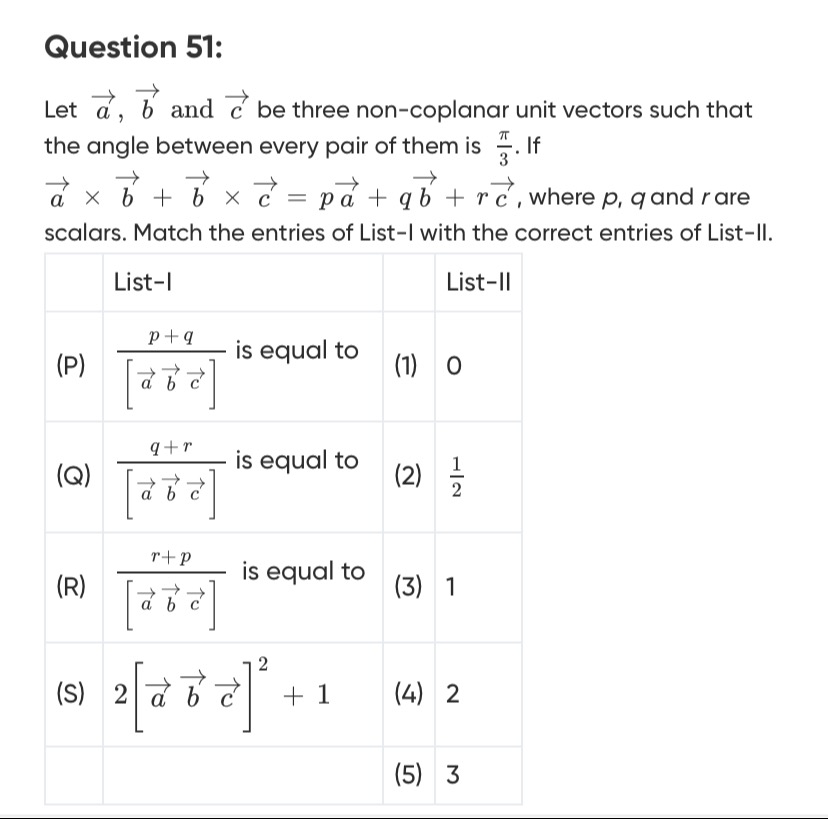Question
Question: Let $\overrightarrow{a}$, $\overrightarrow{b}$ and $\overrightarrow{c}$ be three non-coplanar unit v...
Let a, b and c be three non-coplanar unit vectors such that the angle between every pair of them is 3π. If a×b+b×c=pa+qb+rc, where p, q and r are scalars. Match the entries of List-I with the correct entries of List-II.

[a b c]p+q is equal to
[a b c]q+r is equal to
[a b c]r+p is equal to
2[a b c]2+1
(P) - (1), (Q) - (1), (R) - (4), (S) - (4)
Solution
We are given three non-coplanar unit vectors a, b, c with ∣a∣=∣b∣=∣c∣=1 and the angle between any pair is 3π. This means a⋅b=b⋅c=c⋅a=cos(3π)=21.
The square of the scalar triple product is given by the determinant of the Gram matrix: [a b c]2=a⋅ab⋅ac⋅aa⋅bb⋅bc⋅ba⋅cb⋅cc⋅c=11/21/21/211/21/21/21 [a b c]2=1(1−1/4)−1/2(1/2−1/4)+1/2(1/4−1/2)=3/4−1/8−1/8=3/4−1/4=1/2 Let S=[a b c]. So, S2=1/2.
We are given a×b+b×c=pa+qb+rc. Taking dot product with a, b, c:
- (a×b+b×c)⋅a=p∣a∣2+q(b⋅a)+r(c⋅a) 0+[b c a]=p(1)+q(1/2)+r(1/2)⟹S=p+q/2+r/2
- (a×b+b×c)⋅b=p(a⋅b)+q∣b∣2+r(c⋅b) [a b b]+0=p(1/2)+q(1)+r(1/2)⟹0=p/2+q+r/2
- (a×b+b×c)⋅c=p(a⋅c)+q(b⋅c)+r∣c∣2 [a b c]+0=p(1/2)+q(1/2)+r(1)⟹S=p/2+q/2+r
From (2), p+2q+r=0⟹p+r=−2q. Adding (1) and (3): 2S=(p+p/2)+(q/2+q/2)+(r/2+r)=3p/2+q+3r/2. 2S=23(p+r)+q. Substitute p+r=−2q: 2S=23(−2q)+q=−3q+q=−2q⟹q=−S. Since p+r=−2q, we have p+r=−2(−S)=2S.
Substitute q=−S into (1): S=p−S/2+r/2⟹p+r/2=3S/2. We have: p+r=2S p+r/2=3S/2 Subtracting the second from the first: r/2=S/2⟹r=S. Substituting r=S into p+r=2S: p+S=2S⟹p=S. So, p=S,q=−S,r=S.
Now we evaluate the options: (P) Sp+q=SS+(−S)=S0=0. This matches List-II (1). (Q) Sq+r=S−S+S=S0=0. This matches List-II (1). (R) Sr+p=SS+S=S2S=2. This matches List-II (4). (S) 2[a b c]2+1=2S2+1=2(1/2)+1=1+1=2. This matches List-II (4).
The correct matching is: (P) - (1), (Q) - (1), (R) - (4), (S) - (4).
